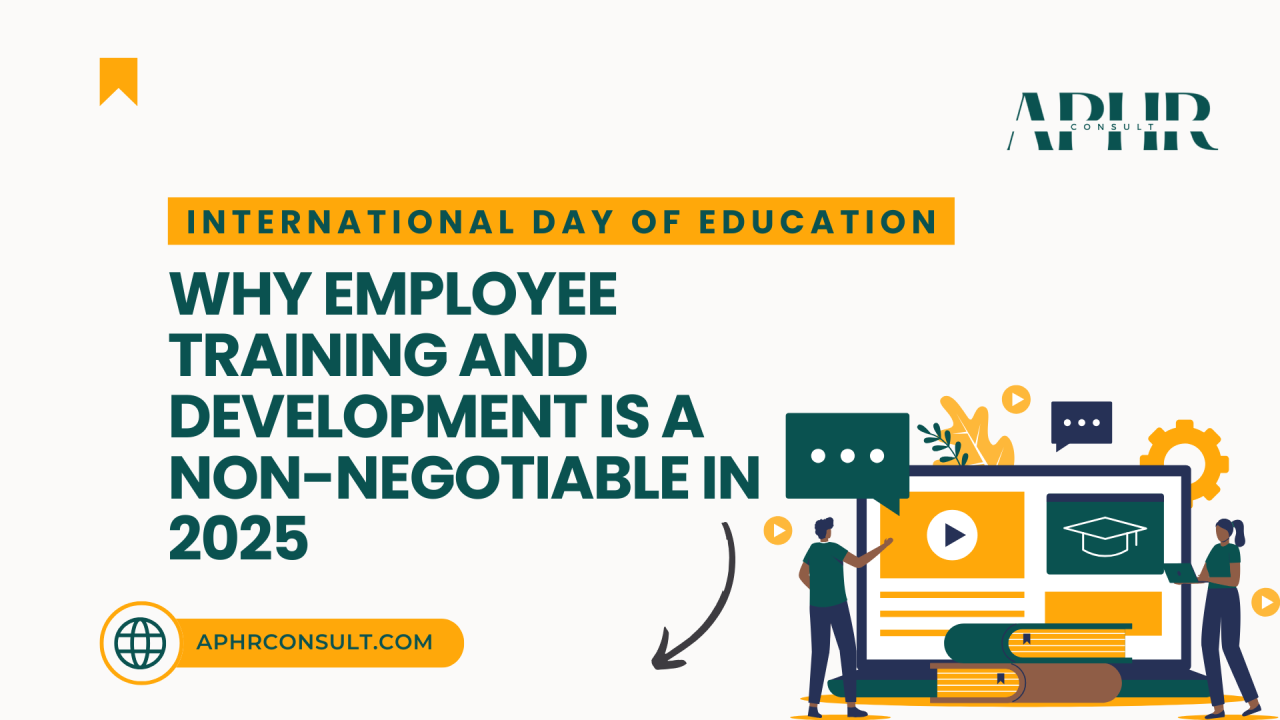INTERNATIONAL DAY OF EDUCATION: Why Employee Training and Development is a Non-Negotiable in 2025
In today’s rapidly evolving world, education transcends traditional classroom settings. As we celebrate the International Day of Education, it is essential to reflect on its role beyond academia, particularly in the workplace. Employee training and development, a cornerstone of modern human resource management, has never been more critical. For businesses striving to stay competitive, investing in their workforce’s education is no longer optional—it is a necessity.
The Future of Work in 2025: Why Training is Critical
The workplace in 2025 is marked by constant technological advancements, increased global competition, and an emphasis on sustainability. Automation and artificial intelligence are transforming industries, demanding new skills from employees. Businesses that fail to prioritize employee training risk falling behind in innovation, productivity, and talent retention.
Employees today expect more than just a paycheck—they seek opportunities to grow, upskill, and advance their careers. Companies that invest in training and development create an engaged, motivated, and future-ready workforce.
The Case for Employee Training: Benefits for Businesses
1. Improved Productivity
Training equips employees with the skills and knowledge necessary to perform their tasks efficiently. Skilled employees work faster, make fewer errors, and contribute to overall organizational success.
2. Adaptability to Change
In 2025, change is constant. Whether it’s adapting to new technologies, navigating market disruptions, or complying with updated regulations, training helps employees stay agile and proactive.
3. Enhanced Employee Retention
Employees are more likely to remain with organizations that invest in their development. Offering training programs shows a commitment to employee growth, reducing turnover rates and associated recruitment costs.
4. Innovation and Creativity
Continuous learning fosters creativity. Employees exposed to new ideas, tools, and methods are better equipped to think critically and contribute innovative solutions to business challenges.
5. Compliance and Risk Management
Training ensures that employees understand legal and ethical requirements, reducing the risk of non-compliance and associated penalties. This is particularly important in industries with strict regulatory environments.
Types of Employee Training to Prioritize in 2025
To maximize the benefits of training, businesses must align programs with current and future needs:
- Digital Skills Training
Digital literacy is no longer optional. From mastering productivity tools to understanding AI and data analytics, employees must be equipped to navigate a tech-driven workplace.
2. Soft Skills Development
Leadership, communication, and emotional intelligence remain vital. As remote and hybrid work models continue, soft skills ensure effective collaboration and team cohesion.
3. Diversity, Equity, and Inclusion (DEI) Training
A diverse and inclusive workplace is not just ethical—it drives innovation and growth. DEI training helps businesses foster a culture of belonging and respect.
4. Compliance and Safety Training
Keeping employees informed about industry regulations, workplace safety protocols, and ethical standards is crucial to maintaining a secure and compliant environment.
5. Leadership Development
Investing in the next generation of leaders ensures smooth succession planning and prepares businesses for future challenges.
Building a Learning Culture: The Key to Success
Employee training should not be treated as a one-off event. To make a lasting impact, businesses must cultivate a culture of continuous learning:
– Incorporate Learning into Everyday Work
Use microlearning tools and on-the-job training to integrate education seamlessly into daily tasks.
– Leverage Technology
E-learning platforms, virtual reality, and AI-driven training tools make learning accessible, engaging, and personalized.
– Encourage Knowledge Sharing
Foster mentorship programs and peer-to-peer learning to build a collaborative and supportive environment.
– Measure Impact
Use performance metrics to assess training effectiveness and align programs with organizational goals.
The Role of HR in Employee Development
HR professionals play a pivotal role in driving training initiatives. From identifying skill gaps to designing tailored programs, HR ensures that training aligns with business objectives and employee aspirations. At APHR, we specialize in creating bespoke training and development strategies that empower businesses to thrive in an ever-changing world.
Conclusion
On this International Day of Education, let’s recognize that education extends beyond schools—it is a lifelong journey. Employee training and development are vital investments that benefit not only individuals but also businesses and society as a whole.
In 2025, staying ahead in the marketplace demands a skilled, engaged, and adaptable workforce. By prioritizing training, businesses can unlock their employees’ potential, drive innovation, and achieve sustainable growth.
If you’re ready to equip your team for success, APHR is here to help. Our tailored training solutions ensure your workforce remains competitive and future-ready. Contact us at hello@aphrconsult.com to learn more.
Similar Articles
FROM HUMAN RESOURCES TO HUMAN IMPACT: HR as the Engine …
Accelerating Action: Practical HR Strategies for Gender Equity International Women’s …
The Cost of Losing Top Talent and How to Prevent …

